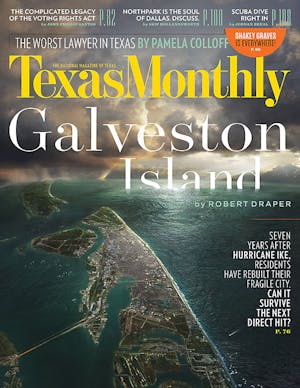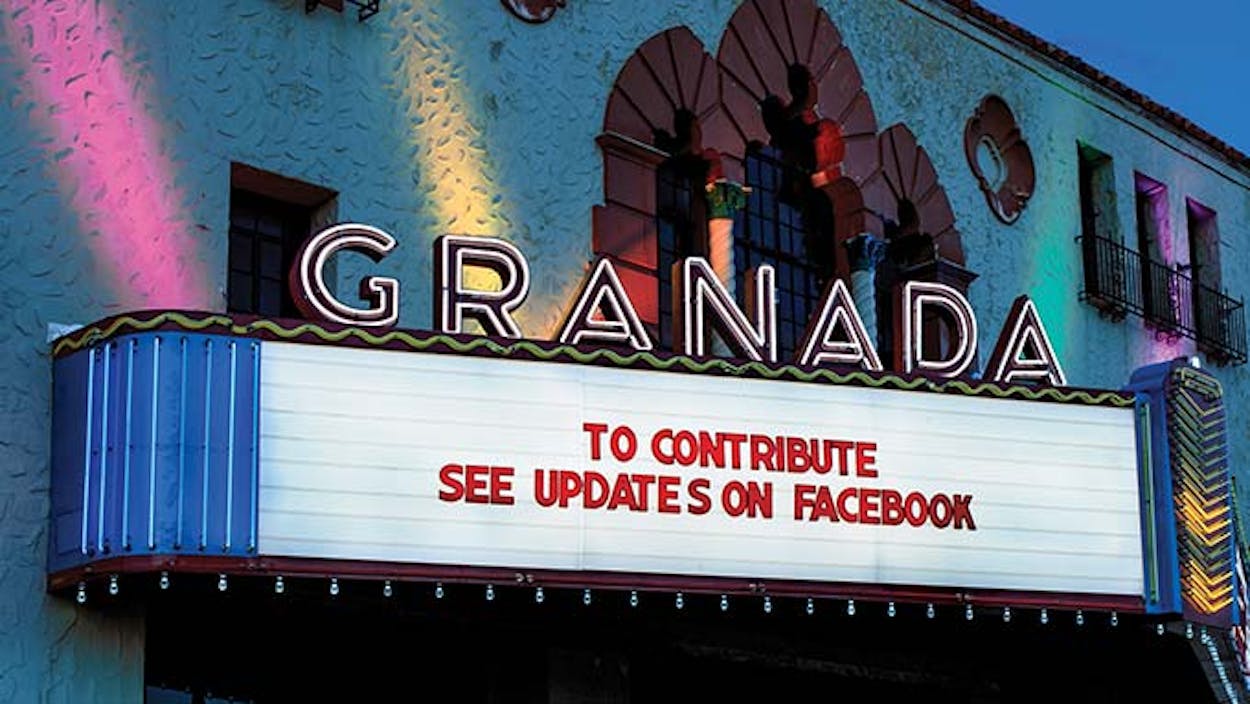The Granada Theatre opened in 1929, when the small town of Plainview was booming. The first train had arrived in 1906, on the Santa Fe Railroad, and waves of settlers followed, drawn to the rich soil of the surrounding plains. Property transactions involved a trip to the nearby Hale County courthouse, and visitors stayed to patronize the local restaurants, hotels, and opera house. For a time, travelers weary of the landlocked Panhandle could rent a rowboat and paddle an artificial lake constructed behind the train station.
The two leading banks in the town of 8,500 had even grander ideas, competing to bring a major hotel chain to town. The bank that hoped to attract Baker Hotel executives included a theater in their plans, and though the bank that was courting Conrad Hilton prevailed, the Granada was completed anyway, just three blocks from the Hilton.
The Granada was an “atmospheric” theater, a style of theater in which the auditorium was decorated with the trappings of a then-exotic land—in the Granada’s case, Spain. The theater was designed to give patrons the illusion of stepping into a castle courtyard; an imitation stone wall made of plaster lined all four sides of the room, small murals of pastoral scenes visible through its windows. Faux birds perched in turrets topped with Spanish tile and dripping with ivy, and statues were tucked into niches. But the feature everyone talked about was the ceiling, a sapphire-blue dome punctuated by twinkling lights that evoked a night sky. Projectors on the walls cast cloud shadows that drifted across its starry expanse.
The Granada was owned by a local man named Chet McSwain, who was also the proprietor of the nearby Fair Theater. For years McSwain’s business rival, Price Holland, ran the local Twin-Vue and Sunset drive-ins as well as the State, a downtown walk-in theater. But in 1957, worried about competition from television, the two men decided to combine their businesses.
Holland retired in the early seventies, but when his young grandson, Darryl Holland, would visit from nearby Lubbock, the older man would bring him along to the Granada, where Price would talk with his buddies. Darryl would steal into the darkened theater, find a balcony seat, and marvel at the clouds on the indoor sky.
In 1977 McSwain sold the Granada to a company that opted to “twin” it, breaking it into two separate theaters. On the Granada’s last night before the remodel, the owners invited Price, Darryl, and Darryl’s father, Wayne, who had been a projectionist there years earlier, to see the Gene Wilder–Richard Pryor comedy Silver Streak. “I knew at that time that it was wrong,” Darryl says of the renovation. “But there’s nothing an eleven-year-old kid can do.” Soon, a construction crew tore out the plaster castle, lowered the ceiling, and installed a dividing wall. The Granada continued operating until September 5, 1997, when it closed for good. Crews stripped the room of its seats and screens, and for the next fifteen years the building sat empty.
Aside from a stint as a music promoter, Darryl Holland has made his career in nostalgia. His Christmas light business supplies theme parks, Nashville stages, and city centers with the ingredients for a holiday wonderland. In 2008, when he realized Lubbock—where he still lives—no longer had a fifties soda fountain, he opened the Holly Hop Ice Cream Shoppe, complete with a vintage jukebox and homemade waffle cones. He sometimes cruises the city’s streets in a pink 1956 Cadillac Coupe DeVille.
So three years ago, when the 48-year-old read that the Granada was for sale on eBay, it was an easy decision to contact the seller, who’d purchased the building a few months earlier, and cut a deal.
“This building is just a shell of what it was, but it can be great again,” he says during a late-May visit to the musty structure. “If we could figure out how to bring this thing back, it would be a catalyst for all of downtown and give people reasons to revive these old buildings.”
Rather than compete with the Cinemark six-screen on the west side of town, Holland is planning to run the Granada as a space for live theater, concerts, the occasional classic-film series, and celebrations like weddings and reunions. In its golden age, the theater, just off the courthouse square, was where the locals went on weekends, expecting to rub shoulders with their neighbors. “It can be that gathering place for Plainview again,” he says. “So many memories were made here over the years. For a lot of people this was their first date or first kiss.”
But only a shrinking percentage of Plainview residents remember kissing someone beneath that faux starry sky. Today’s townspeople have more entertainment options: youth sports, the mall, Netflix, Minecraft. They’re less likely to seek out a single community gathering spot, other than the high school football stadium on a Friday night.
The courthouse square is no longer the town’s social center. In the early eighties Interstate 27 was built on the west side of the growing town, diverting traffic from Texas Highway 27, which ran four blocks from the square. Over time, businesses migrated to the freeway, and downtown emptied. Travelers driving through Plainview on I-27 are now greeted by the familiar logos of Walmart, Chili’s, and IHOP. An eighty-unit apartment complex is under construction just off the access roads.
By contrast, downtown is quiet. A few buildings along red-brick-paved Broadway, Plainview’s old main street, are vacant. Inside the darkened barber shop, shelves of athletic trophies—possibly offered in return for a team sponsorship—have fallen from the walls, covering the floor with dusty statuettes.
It’s a scene replicated in many of small-town Texas’s original business districts. But in some places the pendulum has begun to swing in the other direction, as interest in reviving urban downtowns spreads to rural areas. Eighty-eight Texas towns, including Plainview, participate in the Texas Main Street Program, which supports communities trying to rehabilitate their historic business districts by restoring old buildings and promoting downtown merchants.
Often, one of the first structures to be revived is a vintage theater, says Ken Stein, the president and CEO of the League of Historic American Theatres. Such projects have been carried out in Georgetown, Greenville, Lufkin, and Blanco, among other towns.
“The two reasons that people do what Darryl’s doing are that, first, it’s a love story—someone’s in love with the building and they just don’t want to lose it,” Stein says. “The second reason is that, if it’s done correctly, the theaters can be great economic generators.” In the right circumstances, a revived movie theater can have a ripple effect.
Holland isn’t the only person looking to revive Plainview’s old commercial center. The eight-story Hilton hotel was abandoned decades ago, and its windows and interior fell victim to time, vandals, and hailstorms. There was talk of imploding the graffiti-covered eyesore.
But last summer, a group of volunteers fixed up the building’s ground-floor facade, covering the windows with stucco panels and painting them with images of flappers standing in the once grand ballroom. That cleanup is one component of a larger future envisioned by the nonprofit organization Plainview Downtown Restoration, which believes the area is ripe for redevelopment. Those optimistic about a downtown renaissance in Plainview point to Broadway Brew, a thriving coffee shop that opened in 2008. A Lubbock couple have bought two adjoining buildings near the square that they hope to turn into a space that will feature retail shops, an art gallery, and loft apartments.
Two years ago, these dreams would have seemed improbable. Plainview’s economy was sustained for decades by a meatpacking plant, most recently operated by Cargill, that employed more than 2,000 Hale County residents. But in early 2013 the plant closed, and the town’s unemployment rate nearly doubled for a brief period. “Everyone anticipated it would take a big toll,” says Linda Morris, the executive director of the chamber of commerce. But the impact on the town of 21,000 wasn’t as bad as expected. Some Cargill employees transferred to another plant in Friona, 65 miles away. And two thousand wind turbines are coming to Hale County over the next five years, bringing job opportunities with them.
“Rumors of our death have been greatly exaggerated,” prominent local banker and civic activist Mike Fox recently declared.
Three years ago, after he had bought the Granada, Darryl Holland and his father returned to the building for the first time in ages. It bore no resemblance to the theater of their younger days. The decorative elements were long gone, water had leaked into the building, and dozens of pigeons had taken up residence. “Even though it was pretty rough,” Holland says, “I just had this idea of peeling back these layers.”
He started by replacing the roof, tearing out the “twin” wall, and removing the drop ceiling. He finagled a donation of 88 vintage red-velour seats from a Masonic lodge that was closing. Over last year’s Labor Day weekend he invited the public in for a series of four concerts that included appearances by Asleep at the Wheel and the Texas Tornados.
Sometimes Holland comes to the theater alone and sinks into one of the old seats. Inside the dim, cavernous auditorium, the air is laden with an expectant silence. In the quiet he tries to remember the curve of the plaster wall, the clouds floating across the ceiling, the way the theater felt electric in the presence of people.
“When we had the concerts going on, you could feel the life in here,” he says. “You had human life, you had fresh popcorn, we got the air conditioners going—when the building is breathing it’s just a whole different feel.”
The Granada still needs substantial work, but the building has good bones. The four murals that patrons once saw through the castle windows are still visible on the exposed brick, like ancient frescoes in a cathedral. So far, Holland estimates he’s sunk $100,000 into the project, including the purchase of the building. He’s established a nonprofit to run it, and once it’s open, he plans to sell memberships, apply for grants, and hold an annual gala. He figures $2 million is what he needs to turn the Granada into something like the place he once knew. “There are so many things we could do,” he says. “It’s like a Willie Nelson album—phases and stages.”
The word Holland uses more than any other is “magic.” He applies it to the old twinkling lights, the ceiling clouds, the escape from daily life offered by the movies. What may be even more magical is the notion of eliciting $2 million from a town where the median family income was $39,000 before the Cargill plant closed. But Holland is undeterred.
“This was downtown’s crown jewel in its day,” he says. “It needs a lot of cosmetics, but the heart and the soul and the memories that people have connected to this—they’re still here.
“Maybe it’s crazy, but I just don’t know what else to do. It seems right.”







